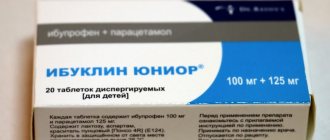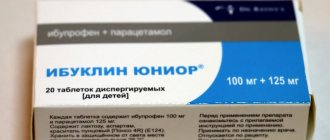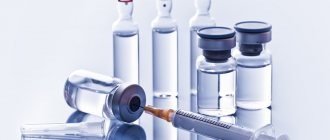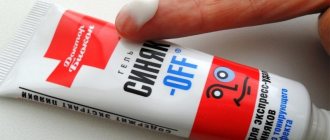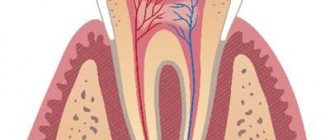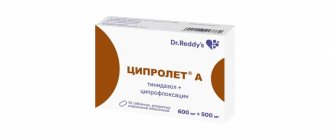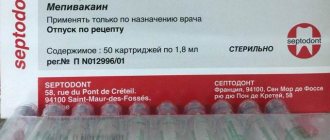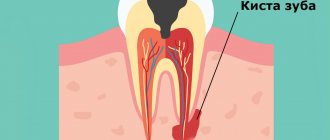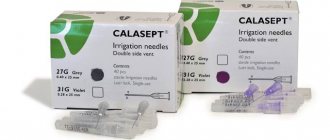Pharmacological properties of the drug Mepivacaine
Local anesthetic of medium duration of action of the amide group. Causes a reversible block of nerve conduction by reducing the permeability of neuron membranes to sodium ions. Compared with lidocaine, mepivacaine causes less vasodilation and has a more rapid onset and longer duration of action. Systemic absorption of mepivacaine depends on the dose, concentration, route of administration, degree of tissue vascularization, and degree of vasodilation. When anesthetizing the teeth of the upper and lower jaw, the effect develops after 0.5–2 and 1–4 minutes, respectively. Dental pulp anesthesia lasts for 10–17 minutes; soft tissue anesthesia in adults lasts 60–100 minutes. When administered epidurally, the effect of mepivacaine develops after 7-15 minutes, the duration of action is 115-150 minutes. Distributed in all tissues, maximum concentrations are created in well-perfused organs, including the liver, lungs, heart and brain. Mepivacaine undergoes rapid metabolism in the liver and is inactivated by hydroxylation and N-demethylation. Three inactive metabolites are known: two phenolic derivatives, which are excreted as glucuronic conjugates, and 2′,6′-pipcolocylide. Approximately 50% of pepivacaine is excreted in the bile as metabolites and undergoes enterohepatic recirculation followed by renal excretion. Only 5–10% is excreted unchanged in urine. A certain amount of the drug is metabolized in the lungs. The metabolism of mepivacaine in newborns is limited; the drug is excreted in unchanged form. The half-life is 1.9–3.2 hours in adults and 8.7–9 hours in newborns. Penetrates the placenta through passive diffusion.
For whom is mepivacaine contraindicated?
When breastfeeding, dental treatment of a woman with Mepivacaine anesthesia is completely prohibited. Also prohibited are children under 4 years of age and weighing less than 20 kilograms, patients with low blood pressure, severe heart and liver diseases. Here the dentist will select another drug, for example, Articaine.
The anesthetic should also be used with caution in the following patient groups:
- in children,
- in pregnant women,
- in elderly people over 65 years of age, a minimum dose of Mepivacaine is used,
- in persons with liver or kidney disease,
- in the presence of diabetes mellitus,
- with pronounced inflammation of the gums,
The product should be used with caution in children
Use of the drug Mepivacaine
Infiltration anesthesia: For adults, up to 40 ml of 1% solution (400 mg) or 80 ml of 0.5% solution (400 mg) in divided doses over 90 minutes. For blockade of cervical nerves, brachial plexus, intercostal nerves: Adults - 5–40 ml of 1% solution (50–400 mg) or 5–20 ml of 2% solution (100–400 mg). Paracervical blockade: Adults up to 10 ml of 1% solution on each side. Inject slowly with an interval of 5 minutes between injections on the other side. Peripheral nerve block: Adults 1–5 ml of 1–2% solution (10–100 mg) or 1.8 ml of 3% solution (54 mg). Infiltration anesthesia in dentistry: Adults - 1.8 ml of 3% solution (54 mg). Infiltration is performed slowly with frequent aspiration. In adults, 9 ml (270 mg) of 3% solution is usually sufficient to anesthetize the entire oral cavity. The total dose should not exceed 400 mg. Children: 1.8 ml of 3% solution (54 mg). Infiltration is performed slowly with frequent aspiration. The maximum dose should not exceed 9 ml (270 mg) of 3% solution. Epidural or caudal anesthesia: Adults - 15–30 ml of 1% solution (150–300 mg), 10–25 ml of 1.5% solution (150–375 mg) or 10–20 ml of 2% solution (200–400 mg). Maximum doses: Adults: 400 mg as a single dose for regional administration; the maximum daily dose is 1000 mg. Children: 5–6 mg/kg. For children under 3 years of age or weighing less than 13.6 kg, mepivacaine solutions are used in concentrations up to 2%.
Read more about restrictions during pregnancy and lactation
As noted above, Mepivacaine is contraindicated during lactation (i.e., breastfeeding). If the clinic simply does not have any other anesthetics, then treatment can be carried out in an emergency. However, the woman will have to skip 2-3 feedings (at least 10 hours must pass after the injection) - the child will be temporarily transferred to an artificial formula, and her own milk will be expressed and poured out. Because the substance passes into breast milk and may harm the baby. The anesthetic is allowed for pregnant women, but it is used with caution - especially if the expectant mother has kidney problems or swelling in the legs or face. To avoid complications, it is better to give preference to a less toxic product.
Drug interactions Mepivacaine
Local anesthetics (especially when prescribed in large doses) may have an antagonistic effect on neuromuscular transmission compared to cholinesterase inhibitors. The use of local anesthetics with ganglion blockers may increase the risk of arterial hypotension and bradycardia. Patients taking MAO inhibitors concomitantly with local anesthetics have an increased risk of developing arterial hypotension. Local anesthetics may have an additive hypotensive effect in patients taking antihypertensive agents and organic nitrates.
List of pharmacies where you can buy Mepivacaine:
- Moscow
- Saint Petersburg
Indications for use of anesthetic
According to the instructions for use, Mepivacaine is indicated for the following types of anesthesia:
- infiltration: “freezing” injection into the gum, tooth ligament or periosteum,
- intraligamentary: a subtype of infiltration, when injections are placed into the ligaments of the tooth, i.e. between the root and the walls of the bone socket,
- conduction: the anesthetic is injected near large nerves,
- regional (intraosseous),
- intrapulpal: an auxiliary technique, the essence of which is that the injection is placed directly into the dental nerve - the pulp.
The injection of the substance goes directly into the bone tissue of the alveolar process.
That is, Mepivacaine is suitable for such dental interventions as:
- treatment of medium and deep caries,
- treatment of pulpitis and periodontitis,
- tooth root resection,
- tooth extraction,
- preparing teeth for prosthetics,
- plastic surgery of gums and frenulums,
- bone tissue augmentation,
- sinus lift (raising the bottom of the maxillary sinus),
- implantation,
- curettage of deep periodontal pockets associated with gingival exfoliation.
The drug is used for tooth extraction.
Good to know! The drug is considered one of the safest to date. It can be used in older patients (but there are some peculiarities), in people with allergies to other anesthetics, with high blood pressure and mild pathologies of the cardiovascular system. Since adrenaline (epinephrine) is not included in its composition.
What are the alternatives - analogues
Analogues of the anesthetic drug "Mepivacaine" are "Mepivacaine-Binergia" (Russia), "Mepivastezin" (Israel), "Scandonest" (France), "Scandinibsa" (Spain), "Isocaine" (Canada). It is important to understand that analogues may have different contraindications and special instructions for use. Therefore, you need to be careful here.
“I am allergic to freezing injections, or rather, they have a very weak effect. I even once had to remove a tooth that was almost alive. Not much pleasant((But the problem was solved unexpectedly. I went to treat caries, and the dentist suggested not using lidocaine, but some kind of French remedy. He said that if it didn’t work, he wouldn’t take money for the injection. No joke, but this injection really helped Now I only go there for treatment.”
Elena A., review from the woman.ru forum
What you need to know additionally
Special instructions for the use of Mepivacaine are as follows:
- the anesthetic drug is used only in a clinical setting by a professional dentist,
- in case of inflammation of the gums or bones, the anesthetic effect is slightly lower,
- intravenous administration is prohibited,
- You can eat only when the effect of the anesthetic wears off: since loss of sensation can cause you to bite your tongue, cheek or lip,
- slight confusion is possible: therefore, driving after treatment is not recommended. As well as working with dangerous mechanisms, caustic chemicals, and climbing to heights.
What adverse reactions may there be?
Mepivacaine is considered a fairly safe anesthetic in dentistry (if we compare it with earlier, outdated ones). And side effects are extremely rare. The instructions for use indicate that in rare cases the following ailments are possible:
- headache, dizziness, tinnitus,
- anxiety, restlessness, feeling of euphoria,
- drowsiness,
- labored breathing,
- decreased vision,
- nausea, vomiting,
- increased or slow heartbeat,
- swelling of the throat, anaphylactic shock: in this case, the dentist’s office always has a first aid kit equipped with an anti-shock kit.
Side effects may include headache and dizziness.
Do not confuse side effects with normal consequences. After all, loss of tissue sensitivity can occur over a fairly wide area. For example, it is completely normal if after an injection your cheek, tongue, lip become numb, or the pronunciation of sounds is impaired. In a few hours all these manifestations will disappear.
Conservative treatment of hemorrhoids includes the use of topical combination medications (multicomponent ointments, creams or suppositories). In various combinations they may contain anti-inflammatory, antimicrobial, sclerosing, anticoagulant agents, anesthetics, venotonics and reparants. The optimal composition of agents for topical treatment of hemorrhoids has not been precisely established and continues to be discussed. The question remains not entirely clear whether the presence of anticoagulants, antibiotics or anesthetics in the composition has a significant impact on the therapeutic effectiveness, whether they potentiate each other, whether they are necessary and, therefore, mandatory components of therapeutic drugs [1].
This article addresses the following issues:
— what underlies the therapeutic effects of combined drugs;
— what factors influence the strength and duration of action of local therapy;
— the combination of which components in a local remedy, in the opinion of a pharmacologist, can be considered rational;
— issues of safety and tolerability of treatment with local drugs.
Modern pharmacotherapy is targeted in nature (from the English “target” - target). This means that the effect of topical drugs is realized only after binding their active principle to specific structures - targets of action, which are located in the effector cells of inflammation (lymphocytes, macrophages, neutrophils), microvasculature (endotheliocytes, myocytes), in the paravasal space, connective tissue , vascular bed (components of the coagulation system, complement system). If the active component of a topical drug does not recognize and bind to its target of action, it cannot demonstrate its therapeutic potential, i.e., in this case, one can count on, at best, a placebo effect.
Individual components of a targeted drug, as a rule, have one distinct target of action; they “work” according to the principle: “one target - one primary pharmacological effect.” The triad of effects characteristic of NSAIDs in the form of anti-inflammatory, analgesic and antipyretic effects is due to the participation of one target of action (cyclooxygenase enzyme) in various physiological responses. The wide range of pronounced pharmacological effects of corticosteroids, anti-inflammatory, immunosuppressive and antiallergic effects, is also based on the ability of the glucocorticoid molecule to find, recognize and form a complex with its target - corticosteroid receptors [2].
The use of combination drugs takes into account the simultaneous impact on several targets of action (multi-target drug).
The principle of combination therapy, a combination of drugs, including from different pharmacological groups (for example, a combination of an anesthetic and an anti-inflammatory drug), is a priority approach in the treatment of diseases caused by various pathogenetic mechanisms, such as chronic venous disease, acute and chronic hemorrhoids, and their complications [3 ].
So, the therapeutic effect of a targeted drug for local therapy is determined by its pharmacological composition and the ability of individual components to find their molecular targets of action. Let's look at their more detailed characteristics.
Anti-inflammatory component.
Involves the use of glucocorticosteroids or nonsteroidal anti-inflammatory drugs (NSAIDs).
Glucocorticosteroids (GCS) are the most effective known anti-inflammatory drugs; they act on all phases of inflammation and various types of inflammatory response [4]. The influence of GCS extends to the migration of leukocytes to the site of inflammation, the reaction of the microvascular bed (decreased tone, increased permeability and exudation), the formation of pro-inflammatory mediators (arachidonic acid metabolites (eicosanoids), histamine, kinins, chemotaxis factors), remodeling of connective tissue at the final stages of inflammation [ 5]. GCS have an inhibitory/suppressive effect on all of the listed sequential processes of inflammation, which determines their vasoconstrictor, anti-exudative effect. At the same time, GCS reduce the sensitivity of neutrophils and eosinophils to chemotactic factors and reduce cellular infiltration of the inflammation site.
What is the reason for such a wide range of anti-inflammatory activity of GCS?
? The targets of their action, glucocorticoid receptors, are located in all types of cells (with the exception of stem cells). By binding to intracellular receptors, GCS increase the expression of genes responsible for the consolidation of the anti-inflammatory response (transactivation) [6]. The activity of genes involved in the production of pro-inflammatory proteins, on the contrary, is under the negative control of GCS, i.e., in their presence it is inhibited (transrepression). Considering that GCS regulate activity at the genomic level, their effect does not develop immediately, on average 2 hours after application, but is long-lasting (8-36 hours depending on the drug) [7].
Thus, the features of GCS include a unique dual mechanism of suppression of inflammation [8] (Fig. 1).
Rice. 1. Two ways to suppress inflammation with GCS: mechanisms of transactivation and transrepression (interpretation of symbols in the text).
Mechanism of transactivation ( trans - activation
): stimulation of gene transcription and the formation of anti-inflammatory proteins (lipocortin-1, nuclear factor kB inhibitor (I-kB), neutral endopeptidase that destroys bradykinin and tachykinins, IL-1 receptor antagonist).
Mechanism of trans - repression : hormone
receptor complexes (in the form of a monomer) directly and through CBP molecules (cAMP-sensitive element binding protein) interact with transcription factors (NF-kB, AP-1, etc.), which are activated by influence of inflammatory mediators, oxidants and viruses. The result of this is inhibition of transcription of “inflammatory” genes (trans-repression). There is a decrease in the formation of proteins and peptides: inducible forms of COX-2, NOS, PL A2, pro-inflammatory cytokines (IL 1-6, TNF-alpha, GM-CSF), chemokines (IL-8, eotaxin, RANTES, monocyte chemotactic protein, inflammatory protein of macrophages 1-alpha), adhesion molecules (VCAM-1, ICAM-1).
As part of topical medications, one of the GCS line is usually used
: hydrocortisone, methylprednisolone, fluocortolone, betamethasone.
They differ in their chemical structure, ability to be absorbed and reach targets of action, and resistance to metabolism. From a practical point of view, it is important to distinguish them by the strength of their anti-inflammatory action. According to the generally accepted European Miller-Monroe classification, depending on the quantitative content in the drug, fluocortolone and betamethasone belong to strong topical corticosteroids, the rest belong to the group of moderately strong or mild topical steroids (Table 1).
Table 1. Classification of topical steroids by strength [9, with abbreviations]
Although this classification is based primarily on testing the relatively rapid vasoconstrictor activity of corticosteroid drugs, this test also takes into account the absorption of corticosteroids, receptor affinity and the rate of elimination of the steroid from the site of application.
What factors influence the strength and duration of action of local GCS therapy?
The main determinants that determine the activity of external GCS include: 1) the chemical structure of the steroid: the binding strength and duration of existence of the GCS-receptor complex; 2) the concentration of the steroid in the drug; 3) dosage form.
One of the decisive factors is the lipophilicity of the GCS molecule (Fig. 2). The higher the lipid solubility, the easier it is for GCS to penetrate the epithelial barriers of the mucous membrane or skin of the perianal area, the easier it is for GCS to enter the cell and find its targets - intracellular glucocorticoid receptors. The higher the lipophilicity of the GCS, the higher its affinity for biological tissues, and, consequently, the higher the local concentration of steroids [10, 11].
Rice. 2. The influence of the lipophilicity of the GCS molecule on the pharmacological properties of topical preparations containing GCS.
The strength of the binding of GCS to the receptor also directly correlates with the lipophilic properties of the corticosteroid molecule, because It is easier for a nonpolar GCS molecule to stay in the hydrophobic pocket of the receptor [12].
What are pharmacologists and chemists doing to enhance the lipophilic properties of GCS and affinity for receptors? Modernization of the GCS molecule, aimed at increasing the strength of the GCS, includes the introduction of a methyl radical (-CH3), a halogen atom (chlorine or fluorine), the addition of organic acid residues (-acetate, -propionate, -butyrate, -pivalate, -furoate, etc. ). Any of the listed upgrades increases the strength of the GCS.
Let us consider the result of the transformations using the example of fluocortolone pivalate (Fig. 3). Unlike the original natural hormone corticosterone, which has low anti-inflammatory activity, fluocortolone pivalate is classified as a strong corticosteroid. It contains in its molecule, in comparison with the original corticosterone, a fluorine atom, a methyl radical in the 16-position, and a pivalic acid residue (pivalate) in the 21-position.
Rice. 3. Structural changes in fluocortolone pivalate, responsible for the increase in its anti-inflammatory activity compared to corticosterone: fluorine atom (1), methyl radical in C16 (2), pivalic (trimethylacetic) acid residue in C21 (3).
For comparison, let’s look at the structural formula of prednisolone, a synthetic GCS of medium strength (Fig. 4). It differs from the precursor of hydrocortisone (cortisol) only by the presence of a double bond in the first aromatic ring, which leads to an increase in its affinity for GCS receptors, but does not sufficiently change the lipophilic properties of the molecule.
Rice. 4. Structural formula of prednisolone, modification of the molecule in the form of a double bond (1), distinguishing it from the original natural hormone.
The pharmacokinetic parameter commonly used to assess the duration of action of drugs, the plasma half-life (t½), is of little use in relation to topical drugs. Thus, the half-life of fluocortolone in blood plasma is about 100 minutes. Instead of this parameter, it is customary to use biological half-life for GCS - the time during which the drug substance loses half of its pharmacological activity.
Depending on the duration of action (Table 2), GCS are divided into short-acting (8-12 hours), long-acting GCS (12-36 hours) and extra-long-acting (36-72 hours).
Table 2. Classification of GCS by duration of action [13]
Lipophilic GCS molecules tend to “linger” in the tissue compared to hydrophilic GCS with moderate and mild potency [7]. In the instructions for the medical use of topical steroids for the treatment of hemorrhoids, you can find recommendations for 1-, 2- and 3-fold application of the drug during the day. On the first day of pharmacotherapy, to saturate the receptors and accelerate the onset of the development of anti-inflammatory action, a 2-fold dose is recommended. If clinical symptoms improve, you can switch to a single dosage regimen of GCS.
Topical glucocorticoid preparations: balance between potency and safety.
The issue of increasing the safety of therapy is also the targeted chemical modification of the drug substance (“engineering the molecule” [14]. An example confirming this thesis is the peculiarity of the chemical structure of the GCS fluocortolone pivalate.
Fluocortolone pivalate is a prodrug (Figure 5). Its activation occurs during hydrolysis of the molecule with the release of active fluocortolone and pivalic (trimethylacetic) acid. This reaction occurs most intensely in areas of inflammation; undamaged tissues are less metabolically active. It turns out that the pivalate residue “helps” first deliver the GCS to the site of action, and then the fluocortolone molecule “gets rid” of the pivalate. And all this occurs most effectively in the zone of therapeutic action of GCS. Fluocortolone pivalate enters the systemic circulation mainly in the form of an inactive prodrug, which reduces the risk of a resorptive effect and increases the safety of therapy. After a single rectal application of 1 g of cream or the introduction of one suppository, the absorption of the glucocorticosteroid was a maximum of 5% of the applied or administered amount of the drug.
Rice. 5. Chemical transformation of the pharmacologically inactive (prodrug) fluocortolone pivalate into the active GCS fluocortolone.
The most commonly prescribed NSAIDs are: indomethacin, ibuprofen, diclofenac, ketoprofen, bufexamac. Bufexamac, according to the decision of the regulatory body (European Medicines Agency) in 2010, is recommended for withdrawal from circulation due to allergic complications [15].
All NSAIDs have a limited spectrum of anti-inflammatory action and, unlike GCS, have not found use in dermatological practice. Their use in the treatment of hemorrhoids and its complications also does not have a high level of evidence in international clinical guidelines [16]. On the contrary, when treating internal hemorrhoids, it is recommended to avoid taking NSAIDs, as they increase the risk of hemorrhagic complications.
Heparin. Among the indications for prescribing local drugs with heparin are: external and internal hemorrhoids, thrombophlebitis of hemorrhoidal veins of the anus, fistulas, eczema, itching in the anus, etc. [1].
A contemporary review from 2015 [17] analyzed available published data from studies on the efficacy and safety of topical anticoagulant therapy from January 1, 1990 to January 1, 2013.
The review authors identified a total of 43 studies, of which only one study focused on topical antithrombotic therapy for acute hemorrhoids [18].
This controlled study included 89 patients, 67 patients were prescribed topical heparin paste, and 22 patients in the control group were treated with a paste containing glycerin and magnesium sulfate. To 30 g of the original heparin ointment (200 IU sodium heparin/g ointment) 10 tablets containing the enzymes trypsin and chymotrypsin (in a 6:1 ratio, equivalent to 100,000 units of enzymatic activity) were added. The resulting paste was applied 3 times a day to the inflamed areas for 4 weeks. Treatment with heparin and enzymes was found to improve healing and resolution of acute hemorrhoids, with 91% of patients experiencing greater relief of symptoms compared to traditional treatment. Side effects were observed in 9% of patients due to hypersensitivity to the paste, and their treatment was discontinued. Based on the study design, it can be assumed that the use of heparin in combination with enzymes increases its bioavailability. It should be noted that there is a very high frequency of side effects and a long treatment period (1 month). Thus, it is not possible to evaluate the effectiveness of local anticoagulant therapy for hemorrhoids based on this study.
It is known to use a conductor (diethanolamine) in the composition of a topical heparin preparation, which ensures “active uniform transport of heparin molecules across the skin barrier” [19]. However, the text of the article and the instructions for medical use of the drug do not contain quantitative data on the parameters of local and systemic pharmacokinetics of heparin.
The use of sodium heparin in topical preparations conflicts with the pharmacokinetic properties of this compound [20]. The high electrical charge of the heparin molecule, high molecular weight (on average 14,000 daltons) - all this opposes the topical use of heparin. Therefore, heparin and its semisynthetic derivatives in the form of low molecular weight heparins (mmw 2500-5000) are administered intravenously or subcutaneously. The intramuscular route of administration is not indicated due to the high risk of hematoma formation. The local use of heparin as part of topical agents is difficult to interpret from the standpoint of rational pharmacology. The anticoagulant effect of heparin is based on the inactivation, in combination with antithrombin III, of blood coagulation factors (thrombin, activated factor X). Thus, the pharmacological properties of heparin directly depend on its ability to penetrate hemorrhoids and bind the target of action of the blood plasma protein antithrombin III. Data on the pharmacokinetics of heparin when administered topically are lacking, and there is no evidence that heparin molecules are able to reach the site of action in therapeutic concentrations. When the integrity of the mucous membrane of the rectum and skin in the anorectal area is damaged, the absorption of heparin increases, although it remains difficult to predict.
Sclerosing agents.
Let's look at the example of lauromacrogol. According to the instructions for medical use, lauromacrogol has a sclerosing and local anesthetic effect [21]. Causes denaturation of proteins in endothelial cells, stimulates the formation of connective tissue inside blood vessels for 7 days. Lauromacrogol is used as part of parenteral dosage forms, so the feasibility of using this component in local therapy requires further study.
Anesthetics.
Anesthetics from the group of local anesthetics, as the name suggests, were developed and introduced into medical practice for the purpose of local anesthesia. Depending on their chemical nature, they are divided into anesthetics containing an ester linkage and amide anesthetics. Ether anesthetics (procaine/novocaine, chloroprocaine, amethocaine) are quickly metabolized, including by enzymes in the blood plasma and cell cytoplasm. It is for them that an allergic reaction is more typical [22]. Amide anesthetics (lidocaine, bupivacaine, articaine, mepivacaine) are more resistant to hydrolysis, are metabolized primarily by the liver, and therefore have a longer period of action. An allergic reaction to lidocaine is much less common.
The targets of local anesthetics (LA) are sodium channels of nerve endings and nerve fibers. Due to the blockade of sodium entry, MAs prevent the generation and conduction of nerve impulses, which underlies the analgesic effect of MAs and their ability to suppress burning and itching sensations. The onset of action of MA occurs quickly, within a few minutes, since it does not require the participation of the genome. The duration of the effect is about 1 hour, increasing to 1.5-2 hours if they are used in combination with a vasoconstrictor (most often adrenaline).
Let us summarize the known data on the dependence of the pharmacological activity of local anesthetics on their structure [23].
The power of action.
Lipid solubility is a major determinant of anesthetic ability. The neuron membrane and nerve fiber sheath are a lipoprotein matrix consisting of 90% lipids and 10% proteins. As a result, chemical compounds with high lipophilicity penetrate the membrane more easily, so that fewer molecules are required to block conduction, resulting in an increased strength of the MA effect.
Duration of anesthesia.
The duration of anesthesia is mainly determined by the degree of protein binding to the various local anesthetics. Most of the information on the protein binding of local anesthetics comes from studies examining the binding of LA to plasma proteins. Therefore, this indicator of the pharmacological activity of LA in antihemorrhoidal drugs is difficult to interpret, since they are poorly absorbed. Thus, lidocaine hydrochloride, unlike lidocaine, is absorbed more slowly and therefore acts longer (several hours) [24].
Apparently, the most significant thing when using MA as part of topical agents is the speed of onset of the effect
. The onset of conduction block is determined primarily by the pKa of the anesthetic, that is, the pH at which ionized and non-ionized forms of the compound are present in equal quantities. Since the uncharged form of the local anesthetic is primarily able to pass through the nerve sheath and nerve membrane, the onset of action of the LA will be directly related to the amount of drug that exists in the unionized form. Based on the speed of onset of the anesthetic effect, MAs are ranked in the following order:
lidocaine > bupivacaine > amethocaine > novocaine.
What combination of components in a local remedy for the treatment of hemorrhoids can be considered rational?
One of the rational combinations of active substances in the composition of a topical drug for the treatment of hemorrhoids is the combination of GCS and lidocaine hydrochloride. Let us examine the advantage of such a composition using the analgesic effect as an example.
The first effect observed is lidocaine hydrochloride, which occurs a few minutes after using a rectal cream or suppository and lasts several hours. The opposite time pattern is typical for the use of the corticosteroid component of the drug: a new portion of GCS will begin to act no earlier than after 2 hours, but the effect is maintained for an incomparably longer period (12-24 hours), since the effect of GCS develops gradually. The use of a combination of GCS and lidocaine hydrochloride has another pharmacodynamic advantage, since it acts on different parts of the nociceptive response. Lidocaine, like MA, prevents the occurrence and conduction of pain impulses in the central nervous system. GCS, due to its antiexudative effect and inhibition of the formation of nociceptive modulators (kinins, histamine, prostaglandins, tissue metabolites formed during inflammation), indirectly reduces the activity of nociceptive stimulation.
Issues of safety and tolerability of treatment with combined local drugs.
Fluocortolone, when applied topically, suppresses inflammatory and allergic reactions of the skin and relieves itching, burning and pain, reduces capillary dilatation, interstitial edema and tissue infiltration [25].
During the period of daily administration of 2 suppositories 3 times a day for 4 weeks, the content of fluocortolone in the blood plasma did not reach a level that had a systemic effect. A 10-year post-registration clinical experience with rectal cream and suppositories containing a combination of fluocortolone pivalate and lidocaine hydrochloride included a total of approximately 4.2 million patients and showed good tolerability of therapy. A topical combination drug in the form of a cream or suppository was prescribed for the symptomatic treatment of rectal and perianal/anal inflammatory processes, including hemorrhoids, anal eczema, anal fissures and proctitis, as well as in pre- and postoperative treatment (i.e. hemorrhoidectomy). During this period, four reports of adverse drug side effects were received, three of which were cases of an allergic reaction with redness, vesicle formation, and itching. In the fourth case, a cream prescribed for rectal administration was also applied to the lower leg, resulting in contact dermatitis with superficial skin ulcers. All patients recovered.
Another example of the relationship between the chemical nature and the safety profile of therapy is the active component of combined local drugs - lidocaine hydrochloride.
The absorption and bioavailability of lidocaine after rectal administration of the cream and suppository is about 30 and 24%, respectively. The kinetics of absorption is characterized by its gradual penetration into the epithelium and underlying tissues. This significantly reduces the risk of systemic undesirable effects of MA: hypotension, cardiac arrhythmias, central effects.
Every time a doctor prescribes a drug, he weighs the benefits and risks of drug treatment. How, using a known set of medicinal substances, can we increase the effectiveness and safety of treatment? The presence of various dosage forms of local drugs in the form of gels, creams, ointments and suppositories allows you to choose the optimal remedy in each specific clinical case, depending on the form, nature of the course and stage of the disease [26]. A rational combination of active substances also helps to increase the effectiveness and tolerability of local therapy for hemorrhoids and its complications.
The authors declare no conflict of interest.
